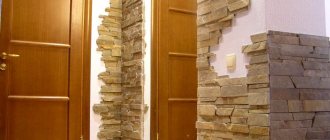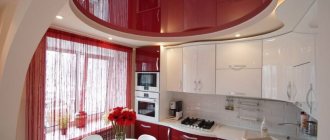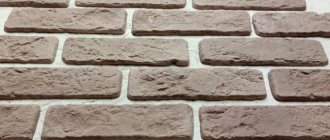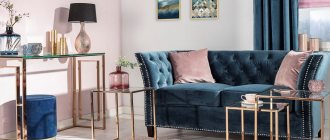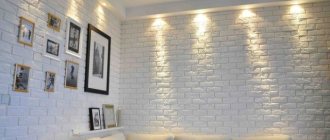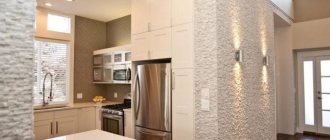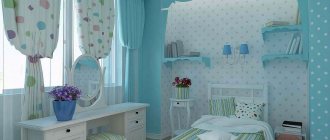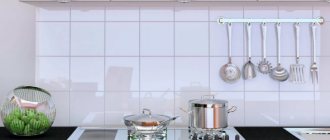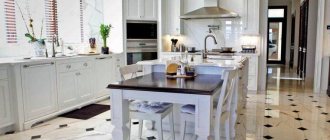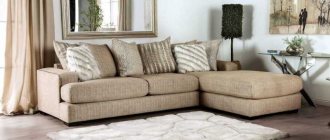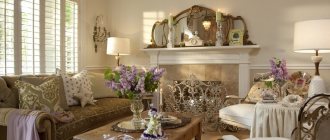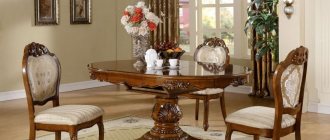A popular design solution for kitchen spaces is finishing the kitchen with decorative stone. The material is resistant to various external influences, has a long service life and is suitable for different styles. The textured surface of the stone looks aesthetically pleasing under any refraction of light.
A bright kitchen with a wall made of relief decorative stone in a classic interior of the dining area Source dizainkuhnibest.ru
There is a large selection of different masonry options, shapes and colors of stone blocks. Walls, columns, kitchen aprons, arches, window or door frames from the inside are decorated with decor. He is involved in zoning and planning the space of the room.
The dark shade of the decorative stone of the working area harmoniously combines with the finishing in the dining area - an imitation of laying wooden logs Source architizer-prod.imgix.net
Compared to tiles, plaster, wallpaper or paint, decorative stone has its own operational advantages. Coating:
- does not corrode;
- resistant to moisture, water, steam;
- has high resistance to ignition;
- heat-resistant – can be placed next to the stove or oven;
- maintains integrity after mechanical impact - impact-resistant;
- easy to maintain - easy to clean;
- easy to install and process;
- environmentally friendly;
- serves for a long time.
The blocks are easy to saw, split, connect, and drill holes in them. Volume protrusions accumulate dust, fumes and dirt. But the material is so versatile that it can be easily cleaned with a vacuum cleaner, brush or sponge. Some types of stone can easily withstand the addition of abrasive, easily soluble cleaning agents (soda-based).
Simple care - dry cleaning of decorative stone with a regular brush or paint brush Source gidpokraske.ru
From a design point of view, stonework creates a textured surface. It makes the room beautiful, stylish, gives the space a special charm and unusualness. There are many shades, textures and block shapes. Some solutions allow you to use combinatorial design - mixing light and dark, cold and warm shades, smooth and embossed blocks.
A light, voluminous decorative stone with rare dark inclusions is laid out on the wall in the recreation area Source nadoremont.com
A stone is often compared to something ancient, ancient, outdated historical, but not forgotten. Therefore, it fits well into styles that require the presence of elements of the past. Decorative stone is good for furnishing interiors in the following styles:
- classical;
- loft;
- country;
- Provence;
- chalet;
- medieval;
- hygge;
- chateau;
- Scandinavian;
- rustic (rustic);
- eco;
- Mediterranean;
- Italian Renaissance;
- eclecticism (mixed).
Provence in the kitchen set and some interior elements looks rich together with an arch made of brick decorative stone Source roomester.ru
The Scandinavian-style kitchen is complemented by a solid finish - a corner wall made of gray stone Source dm-st.ru
Loft style kitchen - decorative stone on the entire wall softens the perception of metal and cold smooth surfaces Source static.tildacdn.com
Kitchen design in the style of a classic chalet is beautifully complemented by decorative stone masonry Source dizainexpert.ru
The rustic style in the kitchen interior contains a beautiful combination of wooden beams and textured large-block masonry of decorative stone Source mykaleidoscope.ru
The hygge style kitchen is decorated along an arched wall with decorative stone - imitation brickwork Source remontbp.com
Advantages of finishing
A stone wall in the kitchen has a number of advantages, including durability and strength; there is no need to make frequent cosmetic repairs. In addition, it is an environmentally friendly and easy-to-install material on the wall that requires minimal maintenance and is available in a wide selection of designs and types.
Decorative stone for the wall can be purchased in the desired size and at an affordable price, which will not burden the wall surface.
Artificial and wild stone
Artificial (decorative) stone
It differs little in appearance from the natural one, repeating its shape, texture and size. It weighs less than natural material and is made from sand and cement.
From a practical point of view, artificial is not inferior to natural, it can be made in any color, and you can decorate the kitchen in different ways. It easily adheres to the surface, is impact-resistant and wear-resistant.
Wild (natural) stone
It is distinguished by its unique origin and unique exclusivity. Natural masonry carries the energy of naturalness, which fills the kitchen with comfort. Durable, does not require special care, shock-resistant, tolerates changes in moisture and temperature.
The photo shows an eco-style kitchen with natural stone on the wall, which is illuminated by spots to create a cozy atmosphere.
Key Features
Every housewife dreams of a beautiful, functional and cozy kitchen. You can create a unique and original design using natural wild or artificial finishing stone, one of the most durable and reliable materials. The decor is durable, stable, chemically neutral, insensitive to moisture and temperature changes. Its undoubted advantage is environmental safety. Of course, such luxury doesn't come cheap. But there are many finishing options, and each is unique. You can cover the walls completely or in separate islands, skillfully combining them with other materials.
Types of natural stone
Marble
It is distinguished by colored veins and is not resistant to kitchen cleaning chemicals. It is better to cover a marble apron or a wall near the sink with a protective layer.
Granite
Granite is equally durable and comes in different shades depending on the place of origin. Tolerates high temperature, moisture, shock.
Travertine
It withstands mechanical stress well, but does not tolerate contact with chemical acidic kitchen cleaning products. Usually gray or white.
Dolomite
It comes in white to brown color, it is used to line stoves, it is heat resistant, and its parameters are similar to granite.
Slate
It comes in yellow, brown, burgundy, green and multi-colored varieties. Thin thickness and smooth surface is suitable for layering.
The photo shows a slate wall in a modern kitchen, which is easy to clean and has a high service life guarantee.
Sandstone
It is a porous rock, its hardness depends on the bonding limestone or quartzite. Used for wall cladding.
Onyx
Shimmers in light and dark layers. Durable, decoratively attractive for wall decoration in the kitchen.
Pebbles
River or rock pebbles of different colors require cleaning to prevent mold from appearing in the spaces between the stones, if this is a kitchen surface with high humidity, or an apron.
The photo shows a black pebble work surface, which is evenly sunk into cement and sanded to a smooth surface for easy cleaning.
"Marbled"
Liquid stone has high performance parameters. The production is based on hermetic polymerization of a sheet of plywood or MDF, cut according to a template, with marble chips.
Thanks to complete enveloping, the canvas does not get wet, but has excessive weight. The cost of the canvas depends on the thickness of the facing layer. The price of $130 per linear meter starts from a layer thickness of 3-5 mm.
Stone and brickwork
Under the stone
It has many varieties, including cladding, installing stones on a flat surface with an adhesive mixture.
A flat view of the kitchen wall is laid with a die, and it is necessary to select and lay it so that there are no obvious voids. Volumetric masonry made of thin stone can be laid smoothly or in relief.
Under the brick
Stone in the kitchen can be laid using American, English, or Flemish bonding.
In the photo, the wall in the work area is lined with granite and highlighted with a niche made of brickwork to resemble a rustic stove.
The “Castle” cladding imitates the masonry of a medieval fortification. A rectangular identical stone is laid according to the “Shahriar” type.
The photo shows brickwork in a modern-style kitchen, where brick performs not only a decorative, but also a practical function.
Care
Despite its sophistication and extraordinary aesthetics, decorative stone is very easy to maintain. Actually, all caring procedures come down to wiping surfaces from dust. Some finishes are sold already varnished. Thanks to this, the decor can be washed just like regular tiles.
There are the following types of care:
- Dry (using a static broom);
- Vacuum cleaning;
- Wet cleaning.
Particularly conscientious and diligent housewives prefer wet cleaning using detergents. But this is truly necessary only when the working area of the kitchen is lined with stone. Coated with a special primer or varnish, the decorative stone perfectly withstands all experiments associated with wet cleaning.
Types of stone for finishing
Piece
Piece or rectangular stone is laid separately, which allows you to create a unique pattern for wall cladding in the kitchen.
Panels
They make work easier, they are quite light when mounted on a wall, and imitate any type of stone. They come in slatted, tile, and sheet sizes up to two meters.
Gypsum stone
Lighter than concrete, treated with acrylic varnish for a long service life. Suitable for kitchen walls made of plasterboard, sold unpainted. Unstable to mechanical stress and high humidity.
Flexible stone
This is the thin top cut of the stone on the fabric. Additionally impregnated for resistance to chemical influences. Suitable for decorating arches, columns, and accent walls in the kitchen.
Plaster
Simulates masonry by creating a relief texture and natural colors, extruding joints. Plaster can create a flat wall that looks like marble or honed stone. Also, the plaster can be flat-relief, convex, imitating textured masonry on the kitchen wall.
The photo shows the wall being finished with plaster with an imitation of a solid stone layer in section. The pink interior is combined with the beige background of the apron.
Design methods
Several walls
You can cover it with stone if the kitchen is medium to large in size. You can make adjacent or parallel walls from boulders in combination with wood or plaster.
One wall
It will attract attention; it is better to decorate a wall free of furniture with stone, for example, near the dining room group.
Part of the wall
Part of the wall can be lined with stone if it is a small kitchen. The part can be upper, lower, or combined with wallpaper.
Stone panel
Framed or edged, stone panels provide decor that can be replaced and moved.
Niches or shelves
Niches or shelves trimmed with stone do not take up much space and create a unique design.
Apron
It can be made from natural or artificial stone, the main thing is to protect it from the formation of mold and mildew due to high humidity near the sink. The stone can be flat, imitating a marble slab, brick, laying with a die is suitable.
Corners, doorways, arches
Corners, doorways or arches in the kitchen can be completely or partially covered with bricks of different sizes, thereby strengthening them.
The photo shows square columns that serve as the entrance to the kitchen, where the apron is lined with pebbles and the countertop is made of granite. The unity of different breeds is harmoniously combined in one interior.
Decorative tiles
A durable coating for kitchen finishing, resistant to moisture, alkalis, and temperature. Outwardly, these are not single blocks, but several connected into a finished composition on a single surface. Due to this, installation is faster, there is no need to select a harmonious combination, the tiles are designed taking into account the nuances. It is used to create aprons, vertical surfaces, trim fireplaces, columns, bar counters and islands. Marble decor and porcelain stoneware slabs are laid on the floor, creating an elegant interior.
Combinations with other materials
You can combine brick or stone on the wall with other finishes to create a varied kitchen interior.
Stone and wallpaper can be combined in an area where the humidity is lower and less susceptible to pollution. Wallpaper can be matched to the color of the stone or highlighted with a bright color. Photo wallpaper in a stone frame will look interesting.
Masonry with wood looks organic in any proportion of wood. This could be laminate, wood panels, cork, wood-look tiles.
The paint can be matched to the color of the stones or you can highlight them with a contrasting wall color.
A stone wall with plaster or paint is suitable for any size kitchen. Venetian plaster looks interesting in combination with flat stone.
Color solution
White
White (quartzite, granite, marble, brick) is suitable for Scandinavian, modern classic kitchen style, expands the space and combines with black, dark brown flooring and wood paneling.
Black
It will add charm to the kitchen, without being too easily soiled. Suitable for a spacious room or in combination with white, brown.
Grey
Gray color (slate, granite, quartzite, marble) will become the background for a bright set, combined with neutral colors.
Red
Red (brick, onyx, granite) attracts attention, is suitable for creating luxury, combined with a red countertop, dark wood.
In the photo, red brick looks organically in a modern interior along with lighting, a glossy facade and a marble floor.
Brown
Brown color accompanies almost all natural wood, combines with wood finishes, adds coziness to the kitchen, and is suitable for any style.
Beige
It is better to combine beige for wall design with dark colors of other finishes, or make it the background for a visually accent set.
Color
Colored with tints, veins, a combination of different colors (pebbles) gives a unique perception of the kitchen, a unique wall will look original and attract attention.
Style selection
The variety of shapes, types of stone and color choice makes it possible to use it as a finish in any style.
Modern style
For a modern kitchen you can choose glossy stone, stone finishes (Venetian plaster), rough natural, painted gypsum stone. It is important to choose the right color that will be the background for the headset, or will become the main highlight.
The photo shows a bright kitchen with stonework in the apron area, which matches the color of the countertop and furniture.
Classic
The classic style allows for cladding only from natural expensive species in yellow, brown, and white. Flat masonry or panels made of onyx and marble will decorate the apron and wall of the dining table.
Loft
A loft is created in the kitchen using gray or red stone on the apron or on one of the walls, which borders on white, gray, black painted surfaces. The furniture and kitchen appliances must match the interior.
Eco style
Eco style involves masonry made of natural rock in combination with wood on the floor or walls. If the kitchen is small, then you can make masonry on the windowsill, part of the surface in combination with a white floor and green walls.
Chalet
The chalet involves a combination of rough wild boulders, pebbles with a bulky wooden ceiling in dark brown and gray. This style can only be created in a spacious kitchen with large windows.
Country
Country style can be created by lining the apron and part of the kitchen in the area of the hob. The countertop or floor can also be made of stone, which differs in several tones.
The photo shows a country-style kitchen, where flat laying of natural stone is combined with rough wood, wooden utensils and decor.
Bar counter
Interior decoration with stone is not only about walls, door and window openings. This material is also used for finishing bar counters. Moreover, this is not only a tabletop. The foot of the counter, decorated with round timber, looks beautiful. As for design solutions, the best option is “eco” or “country” styles. The color scheme is as close to natural as possible. The bar counter looks brutal, deliberately rough. Another option with a bar counter is for a classic interior: covering the wall adjacent to the counter. The color palette of the material is dim and warm, which fully corresponds to the concept of “classicism”. A beautiful design separates the work area from the dining area.
